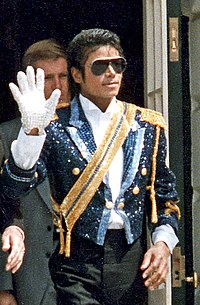Superstar: Difference between revisions
| [pending revision] | [pending revision] |
No edit summary Tag: section blanking |
m Undid revision 293607491 by 190.22.238.74 (talk) |
||
| Line 1: | Line 1: | ||
{{otheruses2|Superstar}} |
|||
[[Image:Madonna 3 by David Shankbone-2.jpg|thumb|200px|[[Madonna (entertainer)|Madonna]] is one of the most recognized celebrities in world with a career spanning nearly 30 years. She is a [[Golden Globe]] and [[Grammy]] winning artist and is commonly referred to as a superstar.]] |
|||
'''Superstar''' is a term used to refer to a [[celebrity]] who has great popular appeal and is widely-known, prominent or successful in some field. Celebrities referred to as "superstars" may include individuals who work as [[actor]]s, [[actress]]es, [[musician]]s, [[sportsperson|athlete]]s, and other professions. |
|||
The term "superstar" is a subjective assessment, and there is no empirical criteria for applying the term. From an economic perspective, Alan B. Krueger's studies of the concept of the "superstar" in the music industry suggest that the top earning bands could be called "superstars". However, the term is also bestowed on individuals by media commentators, critics, and journalists, using aesthetic or other subjective assessment techniques in addition to quantitative criteria, or without quantitative criteria. “Small differences in the skill input of certain individuals may get magnified into large differences in the value of the service when that service can be consumed by a large audience that can share the cost.” As such “many people may each be willing to pay a little more to hear the best performer, who may only be marginally better than the next best performer, producing a superstar salary for the top performer.” This means “even if the top executive of a firm is only slightly more talented than the next best person, that small additional talent is worth a huge amount if it affects thousands of employees or millions of customers.”<ref name=autogenerated5>[http://64.233.161.104/search?q=cache:e8kSPie1GwEJ:highered.mcgraw-hill.com/sites/0070891540/student_view0/chapter13/chapter_notes.html+superstar+economic+rationale&hl=en&gl=ca&ct=clnk&cd=3 403 Forbidden<!-- Bot generated title -->]</ref> |
|||
==History== |
|||
===Early 1900s=== |
===Early 1900s=== |
||
By 1909, the silent film companies began promoting "picture personalities" by releasing stories about these actors to fan magazines and newspapers, as part of a strategy to build “brand loyalty” for their company’s actors and films. By the 1920s, Hollywood film company promoters had developed a “massive industrial enterprise” that “... peddled a new intangible—fame.”<ref name=autogenerated6>[http://64.233.161.104/search?q=cache:1CP1noeuL2wJ:www.adidem.org/articles/MF1.html+movie+star+salary+economic+rationale&hl=en&gl=ca&ct=clnk&cd=45 403 Forbidden<!-- Bot generated title -->]</ref> |
By 1909, the silent film companies began promoting "picture personalities" by releasing stories about these actors to fan magazines and newspapers, as part of a strategy to build “brand loyalty” for their company’s actors and films. By the 1920s, Hollywood film company promoters had developed a “massive industrial enterprise” that “... peddled a new intangible—fame.”<ref name=autogenerated6>[http://64.233.161.104/search?q=cache:1CP1noeuL2wJ:www.adidem.org/articles/MF1.html+movie+star+salary+economic+rationale&hl=en&gl=ca&ct=clnk&cd=45 403 Forbidden<!-- Bot generated title -->]</ref> |
||
Revision as of 23:26, 31 May 2009

Superstar is a term used to refer to a celebrity who has great popular appeal and is widely-known, prominent or successful in some field. Celebrities referred to as "superstars" may include individuals who work as actors, actresses, musicians, athletes, and other professions. The term "superstar" is a subjective assessment, and there is no empirical criteria for applying the term. From an economic perspective, Alan B. Krueger's studies of the concept of the "superstar" in the music industry suggest that the top earning bands could be called "superstars". However, the term is also bestowed on individuals by media commentators, critics, and journalists, using aesthetic or other subjective assessment techniques in addition to quantitative criteria, or without quantitative criteria. “Small differences in the skill input of certain individuals may get magnified into large differences in the value of the service when that service can be consumed by a large audience that can share the cost.” As such “many people may each be willing to pay a little more to hear the best performer, who may only be marginally better than the next best performer, producing a superstar salary for the top performer.” This means “even if the top executive of a firm is only slightly more talented than the next best person, that small additional talent is worth a huge amount if it affects thousands of employees or millions of customers.”[1]
History
Early 1900s
By 1909, the silent film companies began promoting "picture personalities" by releasing stories about these actors to fan magazines and newspapers, as part of a strategy to build “brand loyalty” for their company’s actors and films. By the 1920s, Hollywood film company promoters had developed a “massive industrial enterprise” that “... peddled a new intangible—fame.”[2]
Hollywood “image makers” and promotional agents planted rumours, selectively released real or fictitious biographical information to the press, and used other "gimmicks" to create personas for actors. Then they “...worked [to] reinforce that persona [and] manage the publicity.” Publicists thus "created" the "enduring images" and public perceptions of screen legends such as Rock Hudson, Marilyn Monroe and Grace Kelly. The development of this “star system” made “fame... something that could be fabricated purposely, by the masters of the new ‘machinery of glory.’”[2]
1980s-1990s

In the 1980s and 90s, entertainment publicity tactics have become more subtle and "sophisticated”, such as using press releases, movie "junkets, and community activities". These promotional efforts are targeted and designed using market research, to increase the predictability of success of their media ventures. In some cases, publicity agents may create “provocative advertisements” or make an outrageous public statement to “trigger public controversy and thereby generate "free" news coverage.”[2]
2000-Present
In the 2002 American Idol premiered with the concept to find superstars. Britney Spears has been a huge celebrity and media icon throughout the decade.

"Lottery winner"
According to Roger Caillois, superstars are created by the interplay between “mass media, free enterprise, and competition.” Superstars are produced by a mixture of effort by the actors or athletes and chance (the luck of winning, due to the many arbitrary factors influencing sports, film releases, etc.). The “superstar has extraordinary natural talent augmented by an even more extraordinary perseverance and drive.” However, some “small and relative differences are of decisive importance for winning or losing by a hair’s breadth.” It is here that chance plays a role; a sudden gust of wind at the end of a yachting race can mean the difference between stardom and defeat. Caillois notes that the role of chance in superstardom is paradoxical, given that the west is such a “predominantly meritocratic society,” which valorizes the role of work, competition, activity, and determination.[3]
“[Since] only one may be first. [a person may] choose to win indirectly, through identification with someone else”- the superstar, whose triumph as the most popular actor or hit recording artist is in part due to the actions of “... those who worship the hero”. The public's belief in their own potential for success and wealth is validated by “the manicurist elected Beauty Queen, by the sales girl entrusted with the heroine’s role in a super production, by the shopkeeper’s daughter winning the Tour de France, [and] by the gas station attendant who basks in the limelight as a champion toreador”.[3] For example, Levine points out that "Lars Ulrich, the drummer for Metallica, was a service station attendant before becoming a rich rock star; Harrison Ford was a cabinet maker" before becoming a wealthy film star.[4]
Caillois calls superstars’ huge incomes and rewards “disguised lotteries”, a “special kind of game of chance.” For example, the grand prizes for literary competitions “bring fortune and glory to a writer, for several years.” Caillois notes that a “superstar” cannot merely be successful at some activity; they must also be richly rewarded. He says that the “material reward of the superstar is a necessary ingredient (for the glory of the star) for the identification of the public with the star, or whether it is the excellence or the private life of the star which is of more importance.” He states that superstars’ extravagant incomes play an important psychological “compensating mechanism” role for the public.[3]
According to Madow, “fame is a "relational" phenomenon, something that is conferred by others. A person can, within the limits of his natural talents, make himself strong or swift or learned. But he cannot, in this same sense, make himself famous, any more than he can make himself loved.” Madow goes on to point out that “fame is often conferred or withheld, just as love is, for reasons and on grounds other than "merit." This means that regardless of how “... strenuously the star may ... try to "monitor" and "shape" it, the media and the public always play a substantial part in the image-making process.”[2]
Other meanings
"Superstar" art museums
A small number of major art museums, including Frank Lloyd Wright's Guggenheim Museum in New York, the Centre Pompidou in Paris, Frank Gehry's Guggenheim Museum in Bilbao, among others, have become household names and major tourist destinations. Art museums such as these, with their striking, architecturally-designed buildings and very well-known masterpieces can be termed “superstar” art museums.[5] With their huge visitor traffic, superstar museums are often able to derive a significant income from museum bookshops and restaurants and have a “major impact on the local economy.”.[5]
Superstar museums are able to use the popular appeal of their location and art holdings to produce their own books, videos, and television specials, which adds an additional revenue stream and further reinforces the public’s awareness of the museum. Some superstar museums have also begun establishing museum networks. For example, London’s Tate Gallery has launched satellite art museums at Liverpool and St. Ives.[5].
Cultural institutions such as art museums play a “gatekeeping role” for consumers, helping to screen and grade the cultural artifacts and artworks, thus “reduc[ing] information and search costs” for consumers. Moreover, “by channelling resources to a limited group of visual artists, cultural institutions also enhance superstar phenomena within the visual arts.”[6]
Superstar CEOs
According to the economics theory known as the tournament theory, the multi-million-dollar salaries of superstar chief executive officers (CEOs) in the corporate world with can be viewed as a type of tournament prize. The huge salaries of superstar executives “often seem to resemble prizes for the winners of contests rather than compensation in return for the value of the marginal product of labour.” As an example, “a company may have many vice-presidents of roughly comparable ability and the v-p (who may only be slightly more talented than the others) that is promoted to president receives a huge salary increase, which resembles a prize for winning the contest as best v-p.”[1]
As one description puts it, “...such a compensation system may be efficient if the organization is only able to rank its executives according to the relative value of their contribution to the organization (the organization cannot measure the productivity of each executive, only the productivity of the group of executives).” Moreover, “even if executives are paid a wage equal to the average productivity of the group, there will still be an incentive to perform in order to be promoted and win the prize.” However, “compensation systems that resemble prizes can also create perverse incentives by discouraging cooperative behaviour and may encourage some contestants to disrupt the performance of competitors”[1]
Further reading
- Hamlen, William A. “Superstardom in Popular Music: Empirical Evidence.” Review of Economics and Statistics 73 (1991): 729–33.
- MacDonald, Glenn M. “The Economics of Rising Stars.” American Economic Review 78 (1988): 155–67.
- Rosen, Sherwin. The superstar effect – “The Economics of Superstars”, American Economic Review, 71 (1981).
- Salganik, Matthew J., Peter Sheridan Dodds, and Duncan J. Watts. "Experimental Study of Inequality and Unpredictability in an Artificial Cultural Market." Science 311 (2006): 854-56.
References
- ^ a b c 403 Forbidden
- ^ a b c d 403 Forbidden
- ^ a b c Caillois, Roger. “Games of Chance and the Superstar” in Diogenes, No. 190, Vol. 48/2, 2000 33. Blackwell Publishers Ltd. Available at: http://129.3.20.41/eps/pe/papers/0303/0303003.pdf
- ^ Who wins and who loses?
- ^ a b c 403 Forbidden
- ^ 403 Forbidden
